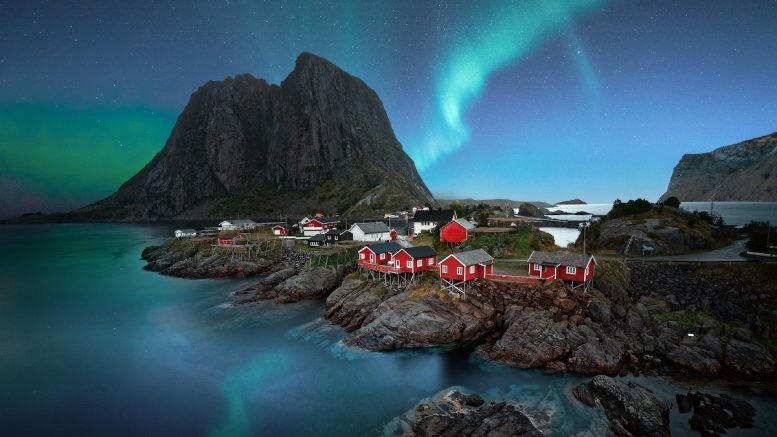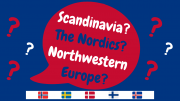The term “Scandinavian country” is usually reserved for only three nations, while the “Nordic countries” encompass a wider geographical area. Learn about Scandinavia (that is, Norway, Denmark, and Sweden) with our A-Z guide to the region.
The nations making up Europe’s northernmost region are most commonly called either Scandinavia – Norway, Denmark, and Sweden – or the Nordic countries – Norway, Denmark, Sweden, Iceland, and Finland.
Contrary to popular belief, each of these terms refers to different, albeit overlapping, areas.
Before we dive into the Scandinavian countries, we’ll outline the reasons behind the separate names.
Scandinavia vs. Nordic countries: Geography, history, and linguistics
Let’s dive in with geography. The so-called Scandinavian Peninsula is made up of Norway, Sweden, and Finland, but the collective word for these countries is “Fennoscandia” – and it isn’t used often.
Finland is the easternmost country on the Scandinavian Peninsula, and it’s separated from the others by the Baltic Sea’s Gulf of Bothnia.
Language is another factor that separates the Scandinavian countries from Finland. Norwegian, Danish, and Swedish are all part of the North Germanic branch of Indo-European languages.
Finnish, on the other hand, isn’t in the Indo-European language family, but the Uralic.
Denmark isn’t part of the Scandinavian Peninsula but has consistent historical connections to both Norway and Sweden, while Finland was also tied to its bordering country, Russia, in the past.
Denmark waged numerous wars with Sweden throughout the centuries, often over Norway. The three countries also unified on and off and in all capacities: all three together, just Norway and Denmark or just Norway and Sweden.
We’ve established a basic overview of why the Scandinavian countries of Norway, Denmark, and Sweden are grouped together and where they are. They cover an area of almost 750,000 square kilometers from north of the Arctic Circle to continental Europe.
Now, read on to deep dive into the Scandinavian countries and capitals, the Scandinavian countries’ religions, Scandinavian cities and their climates, the Scandinavia population (by country and total), the Scandinavian countries’ industries… and much more.
Get to know Norway
Norway, officially the Kingdom of Norway, is a constitutional monarchy. This Scandinavian country’s official languages are Norwegian and Sami with Kven as a regional language and Romani as a minority language.
Norway, like the other Scandinavian countries, consistently tops the highest standard of living lists.
Norway’s population is almost 5.4 million, but most of its inhabitants live in the country’s southernmost regions, which include its largest cities.
Oslo is the capital of Norway and is home to almost 600,000 citizens, while Bergen is home to nearly 300,000. Further north is Trondheim, home to almost 200,000 people, and Tromsø, home to almost 75,000.
Norway’s climate transforms with its terrain, but the rule of thumb is simple: the higher north you get, the tougher the turf, which is why most of the population is centered around the south.
In Oslo, July temperatures average between 13 and 22 degrees Celsius, and January temperatures average between -5 and 0 degrees Celsius.
In Tromsø, July temperatures average between 9 and 16 degrees Celsius, and January temperatures between -6 and -1 degrees Celsius.
Norway stretches over 385,000 square kilometers. The country has 1,000 fjords; the most of any in the world. Its many fjords were carved out over the years by melting and moving glaciers – which can still be found (and hiked!) in the country.
Norway blends magnificent mountainous terrain, with its highest mountain Galdhøpiggen reaching 2,469 meters above sea level, with an island-dotted coastline that stretches around 25,000 kilometers.
Norway has one of the world’s highest gross national incomes per capita, at $68,059. The country’s economy is focused on the oil and gas industries, which account for its biggest exports along with fishing, with a blossoming tourism industry as well. Its official currency is the Norwegian Kroner.
A very secular country, Norway also encourages religious freedom across the board. Lutheranism is the most represented religion in Norway, and the next largest are Protestantism, Catholicism, and Islam. The main public holidays in Norway are Easter (the Sunday following the Paschal Full Moon), Christmas (December 25), and Constitution Day (May 17).
Bonus fact: The Arctic archipelago of Svalbard is part of Norway and sits about halfway between the North Pole and continental Norway. Svalbard is home to the Svalbard Global Seed Vault, a seed storage facility home to the world’s largest – and most secure – collection of every important crop variety in the world.
Millions of seeds are kept safe here as backup storage in the case of a major natural or man-made disaster.
Discover Denmark
Denmark, officially the Kingdom of Denmark, is also a constitutional monarchy. The country’s official language is Danish, with Faroese, Greenlandic and German recognized as regional languages.
Denmark sits on the continental European Jutland peninsula, just north of Germany and just below the other Scandinavian counties.
The capital of Denmark is Copenhagen, which is home to over 750,000 people out of the country’s total population of 5.8 million.
The central city of Aarhus is home to around 300,000 citizens, northern Aalborg well over 200,000, and southern Odense just over 200,000.
Denmark is the Scandinavian country with the smallest and most evenly distributed population.
When it comes to climate, Denmark is more moderate than the other Scandinavian countries. In Copenhagen, July temperatures average between 14 and 22 degrees Celsius, and January temperatures average between -1 and 3 degrees Celsius.
Aalborg’s July temperatures average between 12 and 21 degrees Celsius, and January temperatures average between -3 and 3 degrees Celsius.
Further south, Odense’s July temperatures average between 12 and 22 degrees Celsius, and January temperatures average between -1 and 4 degrees Celsius.
Denmark has an area of just over 43,000 square kilometers. The country is far less mountainous than Norway and Sweden; it mostly features flatlands, with its highest point, the hill of Møllehøj, reaching 171 meters in length. Denmark includes continental lagoons and inlets, as well as over 400 islands scattered across the North Sea.
The gross national income per capita of Denmark is USD 48,836. Denmark’s economy is based on its high-tech agricultural and manufacturing industries, and its main exports are energy and food.
With no area of the country being more than 67 kilometers away from the sea – you can guess which type of food is the main contributor. Tourism also plays a big role. The local currency is the Danish Krone.
Like Norway, Denmark is also secular and promotes religious freedom. Lutheranism is Denmark’s most followed religion, followed by Protestantism, Catholicism, and Islam.
The country’s public holidays include Easter (the Sunday following the Paschal full moon) and Christmas (December 25). While Denmark’s Constitution Day (June 5) isn’t a national public holiday, it’s still celebrated and marked throughout the country.
Bonus fact: The Kingdom of Denmark includes autonomous Greenland and the self-governing Faroe Islands.
Survey Sweden
Sweden, officially the Kingdom of Sweden, is, like the other Scandinavian countries, a constitutional monarchy.
Sweden’s official language is Swedish, while Finnish, Meänkieli, Yiddish, Sami, and Romani are formally recognized minority languages.
Sweden’s population is around 10 million, and, like in Norway, most of its inhabitants live in the country’s southernmost cities. Stockholm is the capital of Sweden and is home to around 1 million citizens.
The country’s second-largest city is Gothenburg, with a population of almost 600,000, and the largest city in northern Sweden is considered to be Umeå, with a population of almost 150,000.
Sweden reserves its most rugged terrain for its northern regions. In Stockholm, July temperatures average between 15 and 24 degrees Celsius, and January temperatures average between -3 and 1 degrees Celsius.
Up north in Umeå, July temperatures average between 11 and 20 degrees Celsius, and January temperatures average between -11 and -4 degrees Celsius.
Sweden stretches over 450,000 square kilometers. While its western side is mountainous and features fjords, most of the country is flatter. Almost 100,000 lakes adorn Sweden.
The country’s highest point is on the Kebnekaise Mountain and reaches almost 2,097 meters.
Another one of the world’s highest-grossing national income per capita countries, at USD 47,955, is Sweden. The country’s economy is focused on energy, agriculture, and manufacturing, with technology on the rise as well. Its official currency is the Swedish Krona.
Sweden is the only Nordic country without an official state church. Lutheranism is the most represented religion in Sweden, and the next largest are Protestantism, Islam, and Catholicism.
The main public holidays in Sweden are Easter (the Sunday following the Paschal full moon), Christmas (December 25), and Sweden’s National Day (June 6).
Bonus fact: Although it’s the Scandinavian country with the largest population, Sweden is so large in mass that it’s one of the least populated countries in Europe.
Has the wanderlust hit yet?
After reading our guide to Scandinavia, you might be experiencing the travel bug – and, given the rich heritage and stunning nature of the region, it’s not surprising.
Our advice? Hit the road: embark on a Tour de Fjord and savor the three Scandinavian countries every step of the way.
Source: Norway Today / #NorwayTodayTravel
Do you have a news tip for Norway Today? We want to hear it. Get in touch at info@norwaytoday.no





I do object to one thing. You claim that Finland “was mostly connected with Russia”. Yes it was but ONLY between 1809-1917! Around 100 years. Before that it was part of Sweden. For almost 700 years! And Swedish together with Finnish, the majority language, is still one of the two official languages of Finland, Finnish and Swedish. So I think some things here should be changed.
Mr C-G Nordquist is right. How come Norway does not know the history of the Nordic countries.